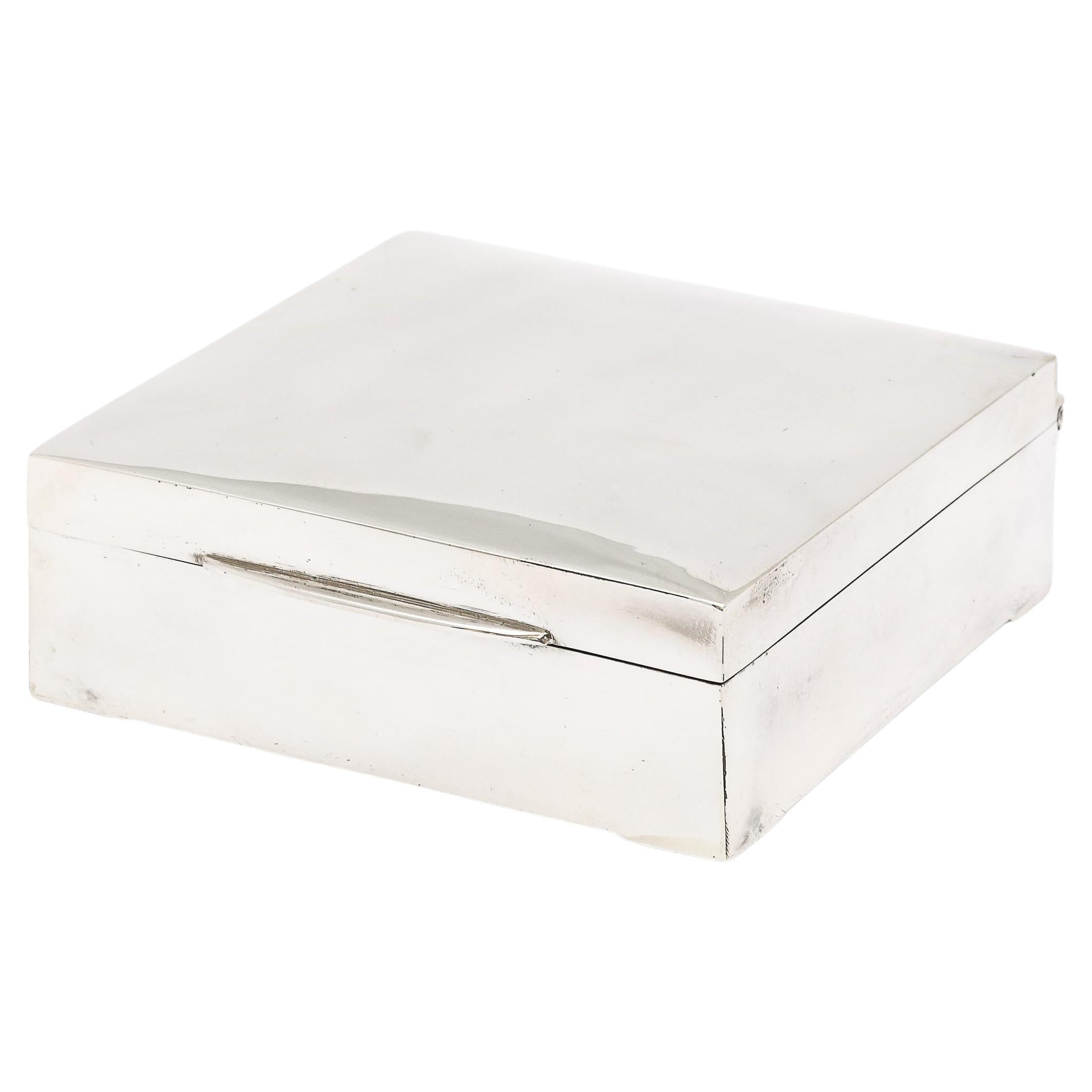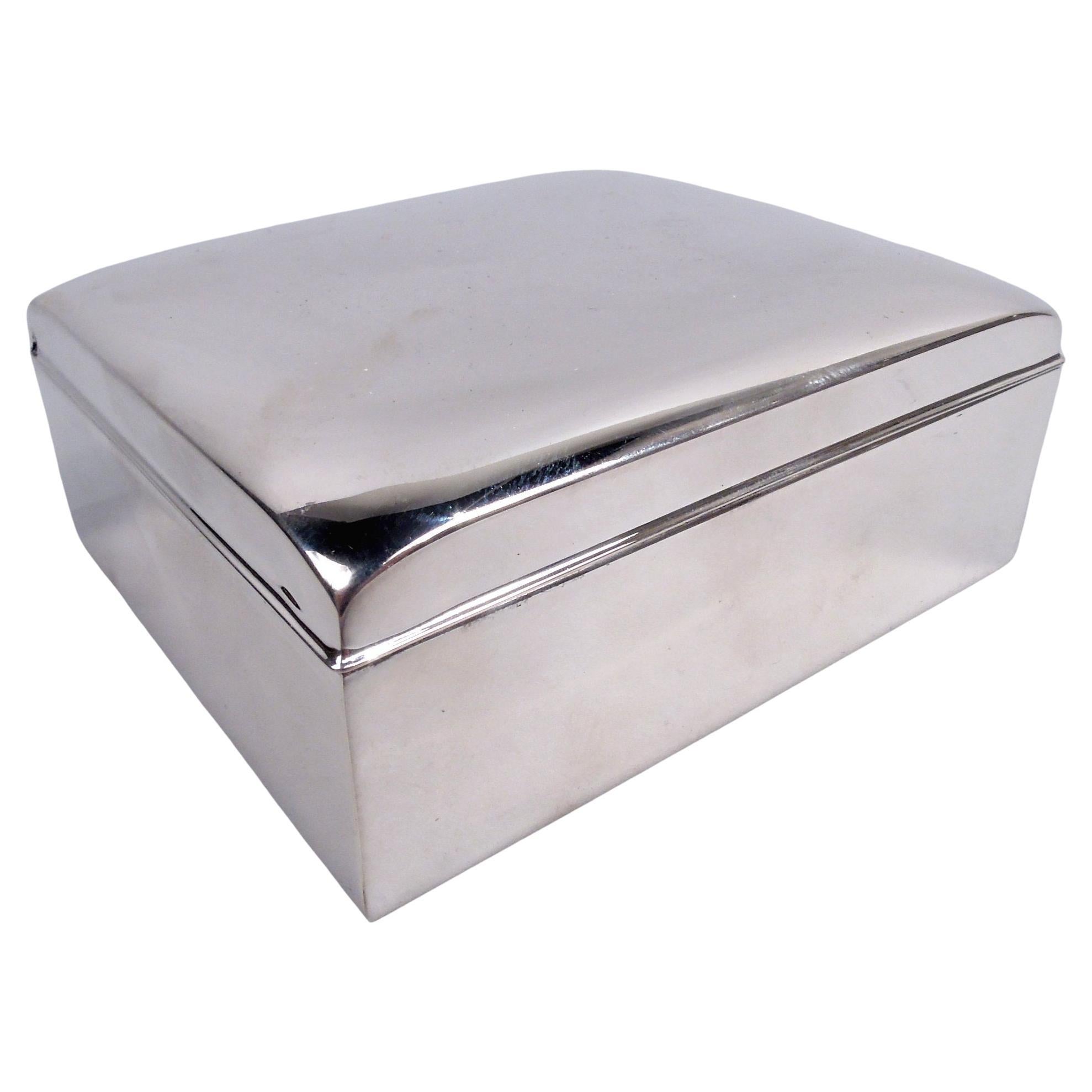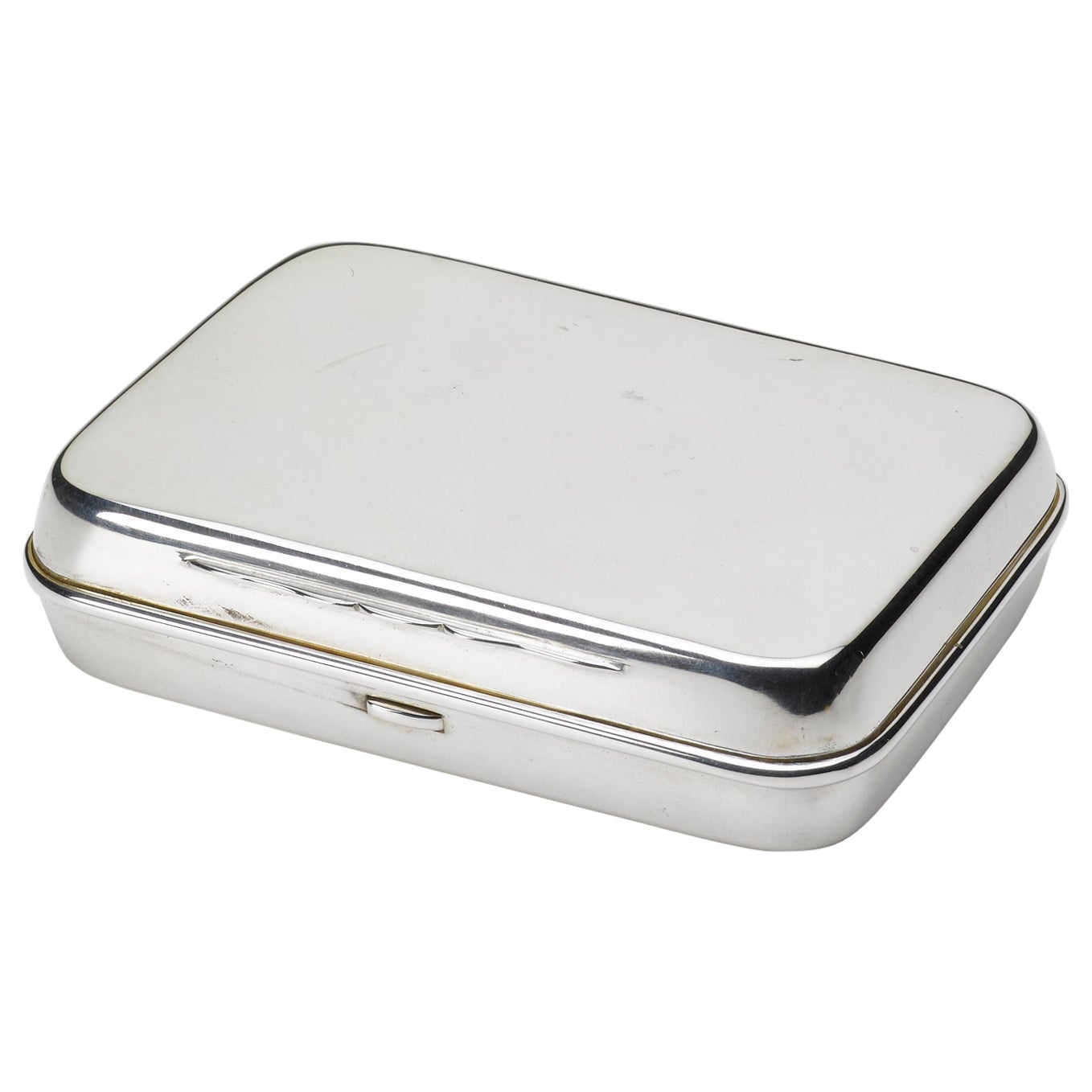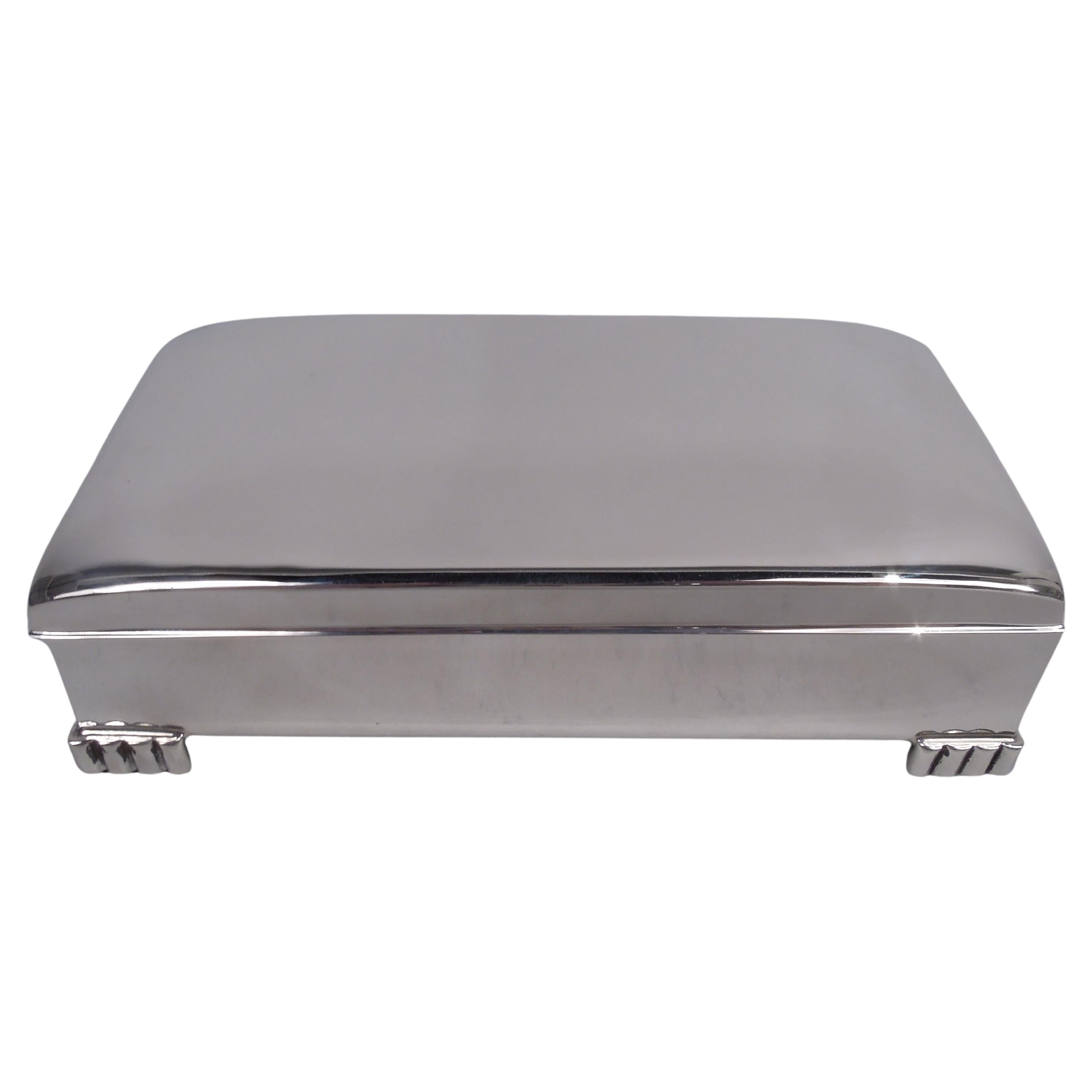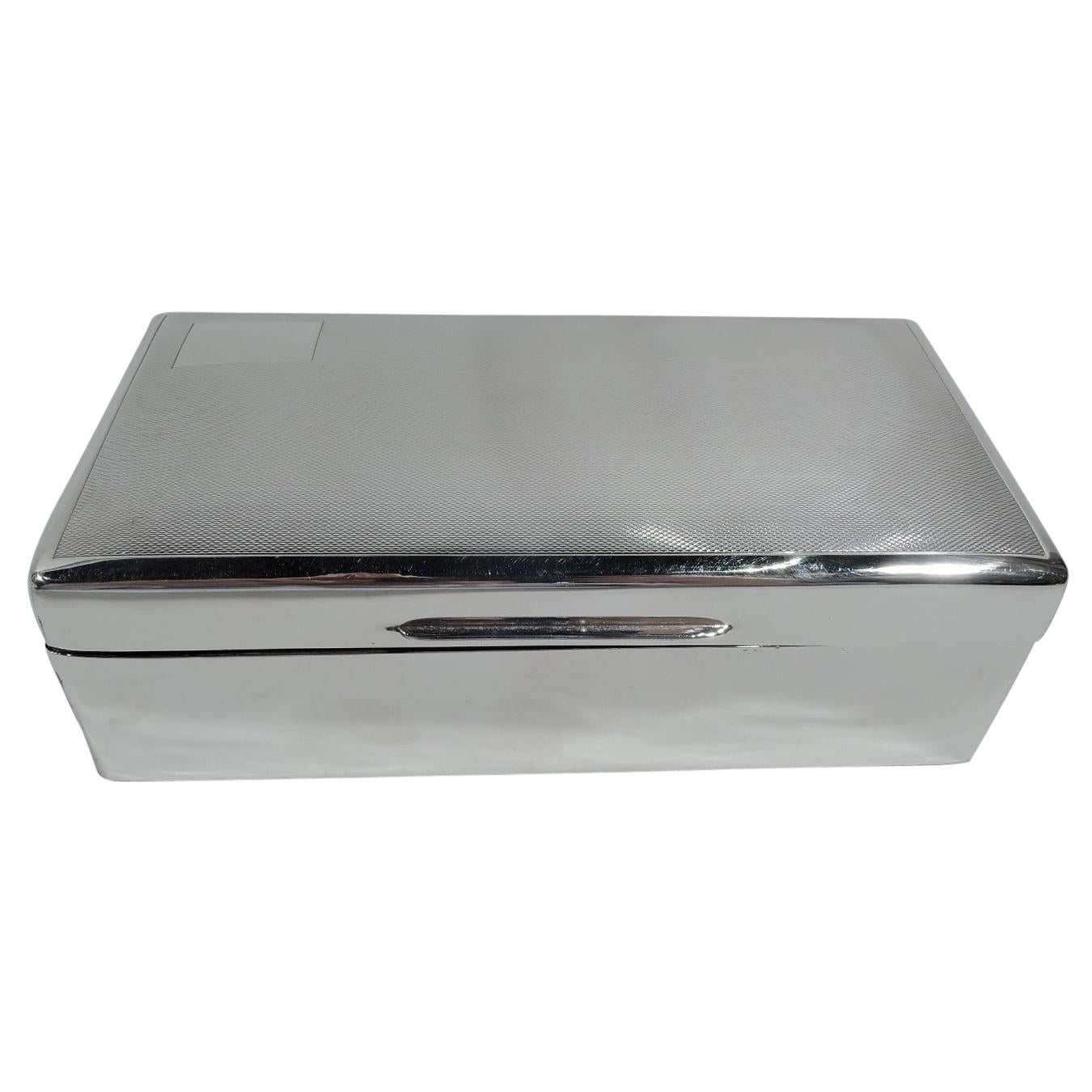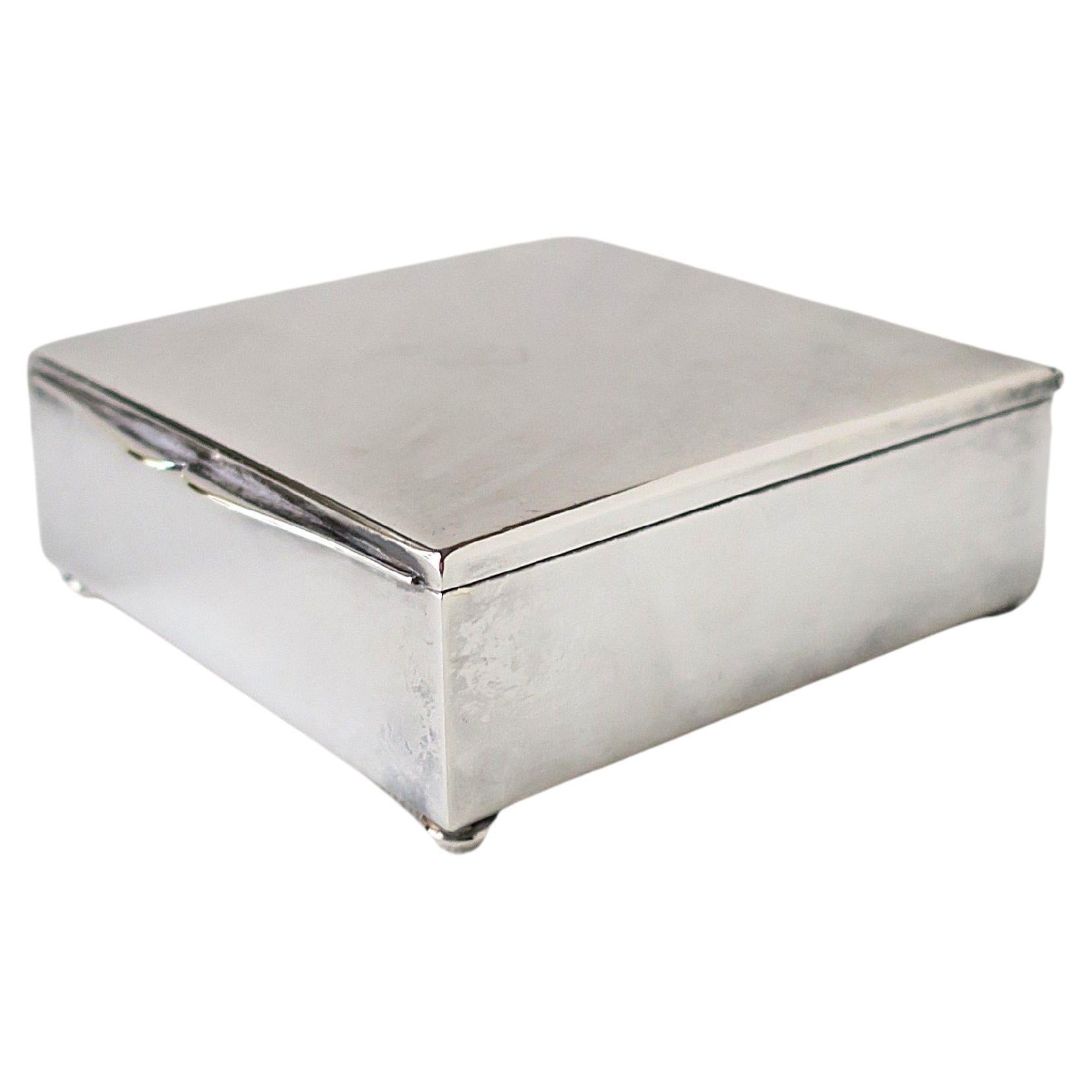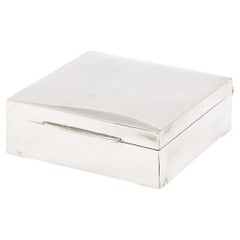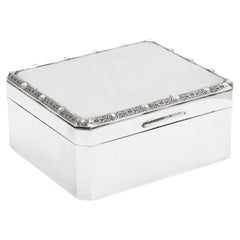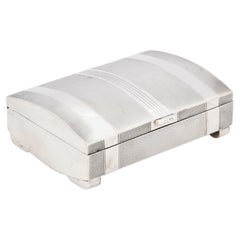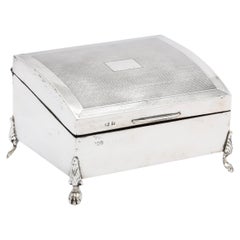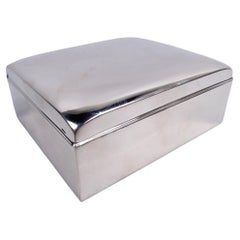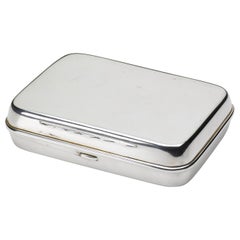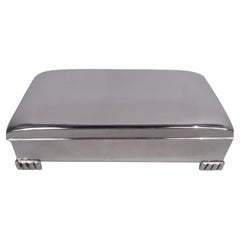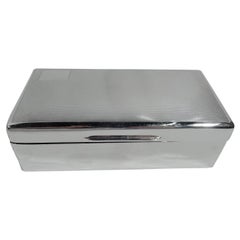Items Similar to Art Deco Period Sterling Silver Table Box
Want more images or videos?
Request additional images or videos from the seller
1 of 14
Art Deco Period Sterling Silver Table Box
$975
£736.75
€852.73
CA$1,367.88
A$1,521.47
CHF 798.16
MX$18,565.41
NOK 10,017.94
SEK 9,440.69
DKK 6,365.23
About the Item
Art Deco Period, sterling silver table box, Poole Silver Co., Taunton, Mass., Ca. 1930's. Wood-lined. Measures 6 inches wide x 3 inches deep x 1 3/4 inches high. Underside is covered in dark leather. There is a dint on the left, front side of the box (see photos) that is commensurate with age and use. Dark areas on sterling silver in photos are reflections. In good antique condition.
- Creator:Poole Silver Co. (Maker)
- Dimensions:Height: 1.75 in (4.45 cm)Width: 6 in (15.24 cm)Depth: 3 in (7.62 cm)
- Style:Art Deco (Of the Period)
- Materials and Techniques:
- Place of Origin:
- Period:
- Date of Manufacture:1935
- Condition:Wear consistent with age and use.
- Seller Location:New York, NY
- Reference Number:1stDibs: LU914742444092
About the Seller
5.0
Recognized Seller
These prestigious sellers are industry leaders and represent the highest echelon for item quality and design.
Platinum Seller
Premium sellers with a 4.7+ rating and 24-hour response times
Established in 1976
1stDibs seller since 2011
667 sales on 1stDibs
Typical response time: 1 hour
- ShippingRetrieving quote...Shipping from: New York, NY
- Return Policy
Authenticity Guarantee
In the unlikely event there’s an issue with an item’s authenticity, contact us within 1 year for a full refund. DetailsMoney-Back Guarantee
If your item is not as described, is damaged in transit, or does not arrive, contact us within 7 days for a full refund. Details24-Hour Cancellation
You have a 24-hour grace period in which to reconsider your purchase, with no questions asked.Vetted Professional Sellers
Our world-class sellers must adhere to strict standards for service and quality, maintaining the integrity of our listings.Price-Match Guarantee
If you find that a seller listed the same item for a lower price elsewhere, we’ll match it.Trusted Global Delivery
Our best-in-class carrier network provides specialized shipping options worldwide, including custom delivery.More From This Seller
View AllArt Deco-Style Sterling Silver Table Box Having a Hinged Lid
By Joseph Gloster
Located in New York, NY
Art Deco-Style, sterling silver, wood-lined table box, having a hinged lid and a leather underside, Birmingham, England, year-hallmarked for 1953, Joseph Gloster, Ltd. maker. Measure...
Category
Vintage 1950s English Art Deco Decorative Boxes
Materials
Sterling Silver
Arts & Crafts-Style Sterling Silver Table Box with Hinged Lid by Adie Bros
By Adie Brothers
Located in New York, NY
Arts & Crafts-style, George VI period, sterling silver table box with hinged lid, Birmingham, England, year-hallmarked for 1949, Adie Bros. - makers. Lovely Celtic design on border o...
Category
Vintage 1940s English Arts and Crafts Sterling Silver
Materials
Sterling Silver
Unusual Art Deco Sterling Silver Table Box With Hinged Lid
By Hassett & Harper Ltd
Located in New York, NY
Unusual, rare, Art Deco Period, footed sterling silver table box with rounded, hinged lid, Birmingham, England, year-hallmarked for 1938, Hassett and Harper Ltd. - makers. Underside ...
Category
Vintage 1930s American Art Deco Sterling Silver
Materials
Sterling Silver
Art Deco Period Sterling Silver Footed Engine-Turned Table Box with Hinged Lid
Located in New York, NY
Art Deco Period, sterling silver, paw-footed, engine-turned-designed table box with with hinged lid, Birmingham, England, year-hallmarked for 1926, Hollings and Hutchinson - makers. ...
Category
Vintage 1920s English Art Deco Decorative Boxes
Materials
Sterling Silver
Victorian-Style Sterling Silver Jewelry/Trinkets Box With Hinged Lid
By Adie Brothers
Located in New York, NY
Victorian-Style, sterling silver jewelry/trinkets box, having paw feet and a hinged lid Birmingham, England, year-hallmarked for 1960, Adie Bros. - makers. Lid is engine-turned in d...
Category
Vintage 1960s English Victorian Jewelry Boxes
Materials
Sterling Silver
Beautiful Edwardian Sterling Silver Table/Jewelry Box With Pull-Out Drawer
By George Nathan & Ridley Hayes
Located in New York, NY
Beautiful, Edwardian period, sterling silver table/jewelry box on ball feet, having a hinged lid and a pull-out drawer (which has a lovely, hinged handle). The box was made in Chest...
Category
Antique Early 1900s English Edwardian Decorative Boxes
Materials
Sterling Silver
You May Also Like
Small American Midcentury Modern Sterling Silver Box
By Poole Silver Co.
Located in New York, NY
Midcentury Modern sterling silver box. Made by Poole in Taunton, Mass. Rectangular with straight sides; cover hinged with curved top. Box interior cedar-lined; underside leather-line...
Category
Mid-20th Century American Mid-Century Modern Decorative Boxes
Materials
Sterling Silver
Hallmarked Silver Plated Keepsake Box, Sheffield, Uk, Circa 1900
Located in Colorado Springs, CO
Offered is a stunning Sheffield silver keepsake box dating to 1900, with associated hallmark. This small box includes a clean interior and rounded corners. The box is free of names or initials, but would have been used to house keepsakes such as jewelry or cufflinks. A well maintained, elegant piece, this antique silver box is an excellent addition to any silver collection.
Trinket or keepsake boxes have taken on many forms since their first conception in ancient times. However their purpose remains the same; to store jewelry and other items precious to the owner. Originally, these boxes were used specifically for jewelry. These were in common use as early as 5000 BC in Ancient Egypt, when the majority of Egyptians, both male and female, wore jewelry. Boxes were used to keep these gemstone encrusted items safe. In Ancient Rome, jewelry was a status symbol. Rings and brooches were utilized to represent ones status in society. Again, boxes were needed for security and storage purposes. Finding early examples of these are quite rare.
Victorian and Edwardian examples of trinket boxes are far more common. This is because owning jewellery was a luxury until the Victorian era- let alone possessing so much a box was needed to store it all. Fine jewelry and other items became available to the masses after the industrial revolution due to the reduction in production costs. This led to a demand for trinket boxes, which were much smaller than jewelry boxes and therefore better suited to the needs of the middle class who did not yet possess an abundance of jewelry.
In Victorian households, collectables and other items of interested were also stashed inside these boxes. This is why they are known as trinket or keepsake boxes, rather than just jewelry boxes, although of course jewelry was also stored in them. Trinket boxes were produced in large numbers around this time. Many were lined with colored plush or velvet or rich wood. More elaborate designs had interior divisions and trays for rings and other pieces of jewellery. It was also common to see trinket boxes so small that they could only contain one item, such as a single ring. Ornate exteriors were created to reflect the value of the trinket boxes contents.
The Edwardian era saw the introduction of new styles of trinket box. These included small circular or oblong boxes...
Category
Antique Early 1900s British Art Deco Decorative Boxes
Materials
Silver
Classic Midcentury Modern Sterling Silver Box by Poole
By Poole Silver Co.
Located in New York, NY
Midcentury Modern sterling silver box. Made by Poole in Taunton, Mass. Rectangular with straight sides and lobed bracket feet applied at corners. Cover hinged and curved. Box interio...
Category
Mid-20th Century American Modern Decorative Boxes
Materials
Sterling Silver
Antique English Art Deco Sterling Silver Box
By Robert Pringle & Sons
Located in New York, NY
George VI sterling silver box. Made by Robert Pringle & Sons in London in 1939. Rectangular with curved corners. Cover hinged and tabbed; top has engine-turned wave ornament and rect...
Category
Vintage 1930s English Art Deco Sterling Silver
Materials
Sterling Silver
Sterling Silverplate German Box
Located in New York, NY
A sterling silver-plate German box with teak wood interior, circa early to mid-20th century, Germany. I'm showing piece as a jewelry box (holding earrings); however, it's actually a ...
Category
Mid-20th Century German Art Deco Snuff Boxes and Tobacco Boxes
Materials
Silver Plate
Hallmarked Silver Plated Keepsake Box, Sheffield, UK, circa 1900
Located in Colorado Springs, CO
Offered is a stunning silver plated keepsake box dating to 1900, with associated hallmark. This small box includes a wooden interior with two slots and a blank square on top where initials could have been engraved. A well maintained, elegant piece, this antique silver box is an excellent addition to any silver or home decor collection.
Trinket or keepsake boxes have taken on many forms since their first conception in ancient times. However their purpose remains the same; to store jewelry and other items precious to the owner. Originally, these boxes were used specifically for jewelry. These were in common use as early as 5000 BC in Ancient Egypt, when the majority of Egyptians, both male and female, wore jewelry. Boxes were used to keep these gemstone encrusted items safe. In Ancient Rome, jewelry was a status symbol. Rings and brooches were utilized to represent ones status in society. Again, boxes were needed for security and storage purposes. Finding early examples of these are quite rare.
Victorian and Edwardian examples of trinket boxes are far more common. This is because owning jewellery was a luxury until the Victorian era- let alone possessing so much a box was needed to store it all. Fine jewelry and other items became available to the masses after the industrial revolution due to the reduction in production costs. This led to a demand for trinket boxes, which were much smaller than jewelry boxes and therefore better suited to the needs of the middle class who did not yet possess an abundance of jewelry.
In Victorian households, collectables and other items of interested were also stashed inside these boxes. This is why they are known as trinket or keepsake boxes, rather than just jewelry boxes, although of course jewelry was also stored in them. Trinket boxes were produced in large numbers around this time. Many were lined with colored plush or velvet or rich wood. More elaborate designs had interior divisions and trays for rings and other pieces of jewellery. It was also common to see trinket boxes so small that they could only contain one item, such as a single ring. Ornate exteriors were created to reflect the value of the trinket boxes contents.
The Edwardian era saw the introduction of new styles of trinket box. These included small circular or oblong boxes...
Category
Antique Early 1900s English Art Deco Decorative Boxes
Materials
Silver
$600 Sale Price
20% Off
More Ways To Browse
Vintage Sterling Silver Box Boxes
Antique Shoe Box
Bone Inlay Ivory
Calligraphy Box
Carl Faberge Eggs
Japanese Papier Mache
Japanned Papier Mache
Table Cigarette Box
Vintage Apple Box
Antique Lap Desk
Asprey Case
Ceramic Bird Box
Leather Letter Box
Chip Carved Box
Seashell Box
1700s Box
Antique Arrow Box
Antique Scent Box
